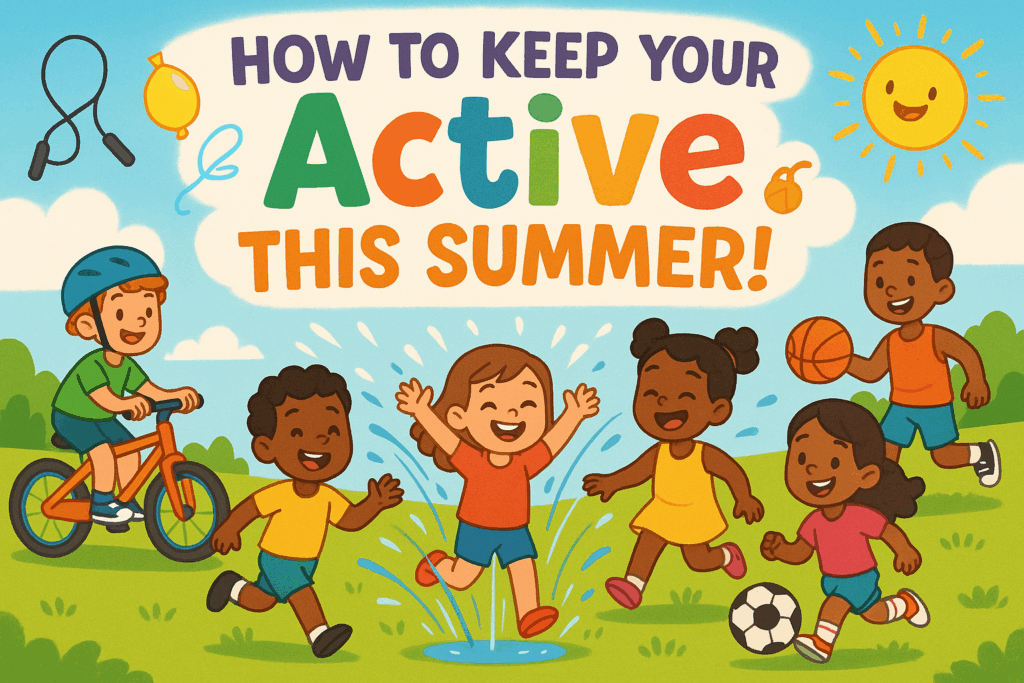
Summer break is a much-awaited time for children—a period of freedom from school routines, homework, and early mornings. However, for parents, it can be a challenge to keep kids engaged, active, and away from excessive screen time. With the right strategies, you can ensure your child stays physically active, mentally stimulated, and socially connected during the summer months.
In this comprehensive guide, we’ll explore fun and effective ways to keep your child moving, learning, and having a blast all summer long.
Why Keeping Kids Active in Summer is Important
Before diving into activities, it’s essential to understand why keeping children active is crucial:
- Physical Health – Regular exercise helps maintain a healthy weight, strengthens muscles and bones, and improves cardiovascular health.
- Mental Well-being – Physical activity reduces stress, boosts mood, and enhances cognitive function.
- Social Skills – Outdoor play and group activities encourage teamwork, communication, and friendship-building.
- Preventing Summer Learning Loss – Active play combined with educational elements helps retain knowledge gained during the school year.
- Reducing Screen Time – Encouraging physical activities limits excessive TV, video games, and smartphone use.
Now, let’s explore the best ways to keep your child active this summer!
1. Outdoor Activities for Maximum Fun and Fitness
A. Sports and Games
Organized sports and casual backyard games are excellent for keeping kids moving.
- Soccer, Basketball, or Baseball – Enroll your child in a local summer sports league or set up mini-games at home.
- Tag, Hide & Seek, and Capture the Flag – Classic games that never get old.
- Obstacle Courses – Use hula hoops, cones, and jump ropes to create a fun backyard challenge.
B. Swimming and Water Play
Beat the heat while staying active with water-based activities:
- Swimming Lessons – Improves fitness and water safety skills.
- Sprinkler or Slip ‘N Slide – Simple, refreshing fun.
- Water Balloon Fights – A playful way to stay cool and active.
C. Biking, Scooting, and Skating
Wheels make exercise exciting:
- Family Bike Rides – Explore local trails or parks together.
- Scooter or Skateboard Races – Set up a safe course in the driveway.
D. Nature Exploration
Encourage outdoor adventures:
- Hiking and Nature Walks – Visit parks and trails; turn it into a scavenger hunt.
- Gardening – Let kids plant flowers or vegetables and care for them.
- Bug Hunting and Bird Watching – Educational and engaging.
2. Indoor Activities for Rainy or Extremely Hot Days
When outdoor play isn’t possible, keep kids moving indoors with these ideas:
A. Dance and Movement
- Dance Parties – Play their favorite music and let them freestyle.
- Yoga for Kids – Improves flexibility and mindfulness.
- Indoor Obstacle Course – Use pillows, chairs, and tunnels for creative challenges.
B. Active Video Games
If screen time is inevitable, opt for interactive games:
- Just Dance, Wii Sports, or Ring Fit Adventure – Combines gaming with movement.
C. DIY Crafts with Movement
- Building Forts – Encourages creativity and physical effort.
- Balloon Volleyball – Play with a balloon in the living room.
3. Enroll in Summer Camps and Classes
Structured programs provide socialization and skill-building:
- Sports Camps – Soccer, basketball, or tennis camps keep kids engaged.
- STEM or Art Camps – Combines learning with hands-on activities.
- Dance or Martial Arts Classes – Great for discipline and fitness.
4. Family Activities to Stay Active Together
Kids are more likely to stay active if parents join in:
- Family Walks or Jogs – Make it a daily habit.
- Backyard Camping – Set up a tent, tell stories, and stargaze.
- Mini Olympics – Organize fun competitions like sack races or tug-of-war.
5. Encourage Creative Play and Unstructured Activity
Free play is essential for imagination and physical development:
- Playground Visits – Swinging, climbing, and sliding provide great exercise.
- Jump Rope or Hopscotch – Simple, effective, and fun.
- Trampoline Time – If you have one, it’s a fantastic energy burner.
6. Limit Screen Time with Smart Strategies
While some screen time is okay, balance is key:
- Set Time Limits – Use timers or parental controls.
- Encourage Active Screen Time – Choose interactive apps or fitness videos.
- Create a Screen-Time Reward System – Earn screen minutes with physical activity.
7. Make Chores Fun and Active
Turn household tasks into games:
- Toy Cleanup Race – Who can pick up toys the fastest?
- Car Washing – A fun, wet, and active chore.
- Gardening Together – Digging and planting burn energy.
8. Incorporate Learning into Physical Activities
Keep their brains sharp while moving:
- Alphabet Scavenger Hunt – Find items starting with each letter.
- Math Hopscotch – Solve equations while jumping.
- Science Experiments with Movement – Create baking soda volcanoes or DIY rockets.
9. Encourage Social Playdates
Kids stay more active with friends:
- Organize Group Games – Relay races, kickball, or tag.
- Neighborhood Bike Rides – Group cycling is more motivating.
10. Set a Routine for Consistency
A loose schedule helps maintain activity levels:
- Morning Outdoor Time – Before it gets too hot.
- Afternoon Indoor Activities – For the hottest part of the day.
- Evening Family Walks – Wind down with movement.
Final Thoughts
Keeping your child active during summer break doesn’t have to be a challenge. By mixing structured activities with free play, limiting screen time, and participating as a family, you can ensure your child stays healthy, happy, and engaged all summer long.
The key is variety—rotate between sports, creative play, nature exploration, and learning-based movement. With these ideas, your child will have a summer filled with fun, fitness, and unforgettable memories!

